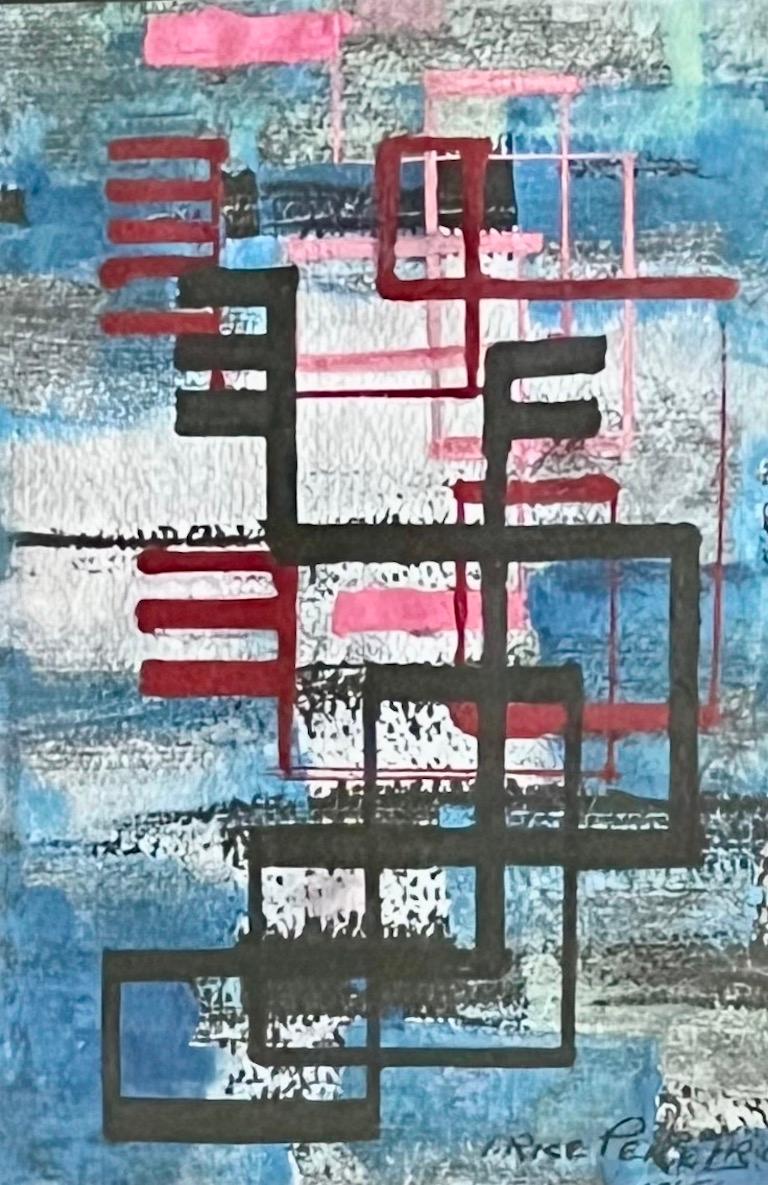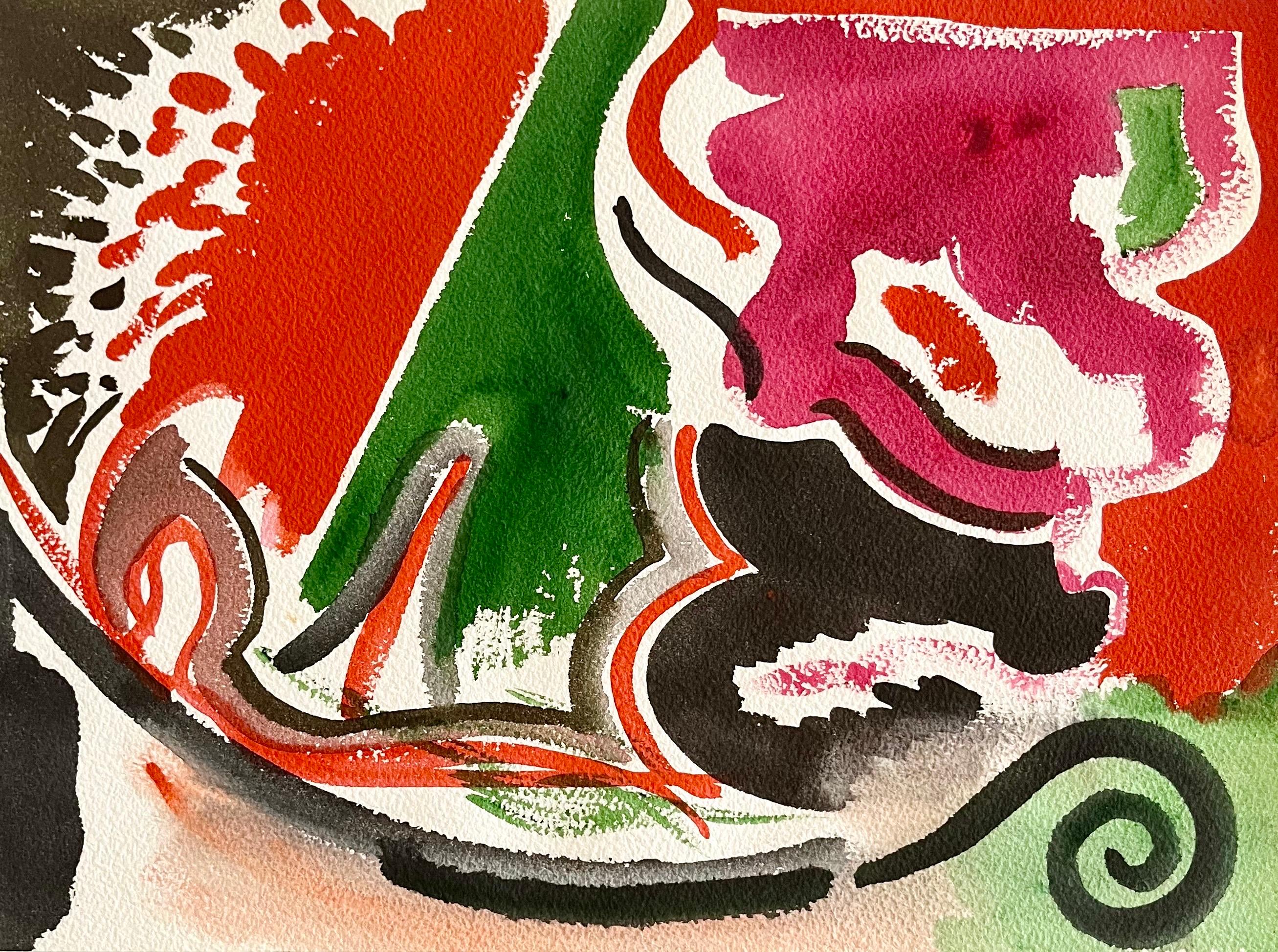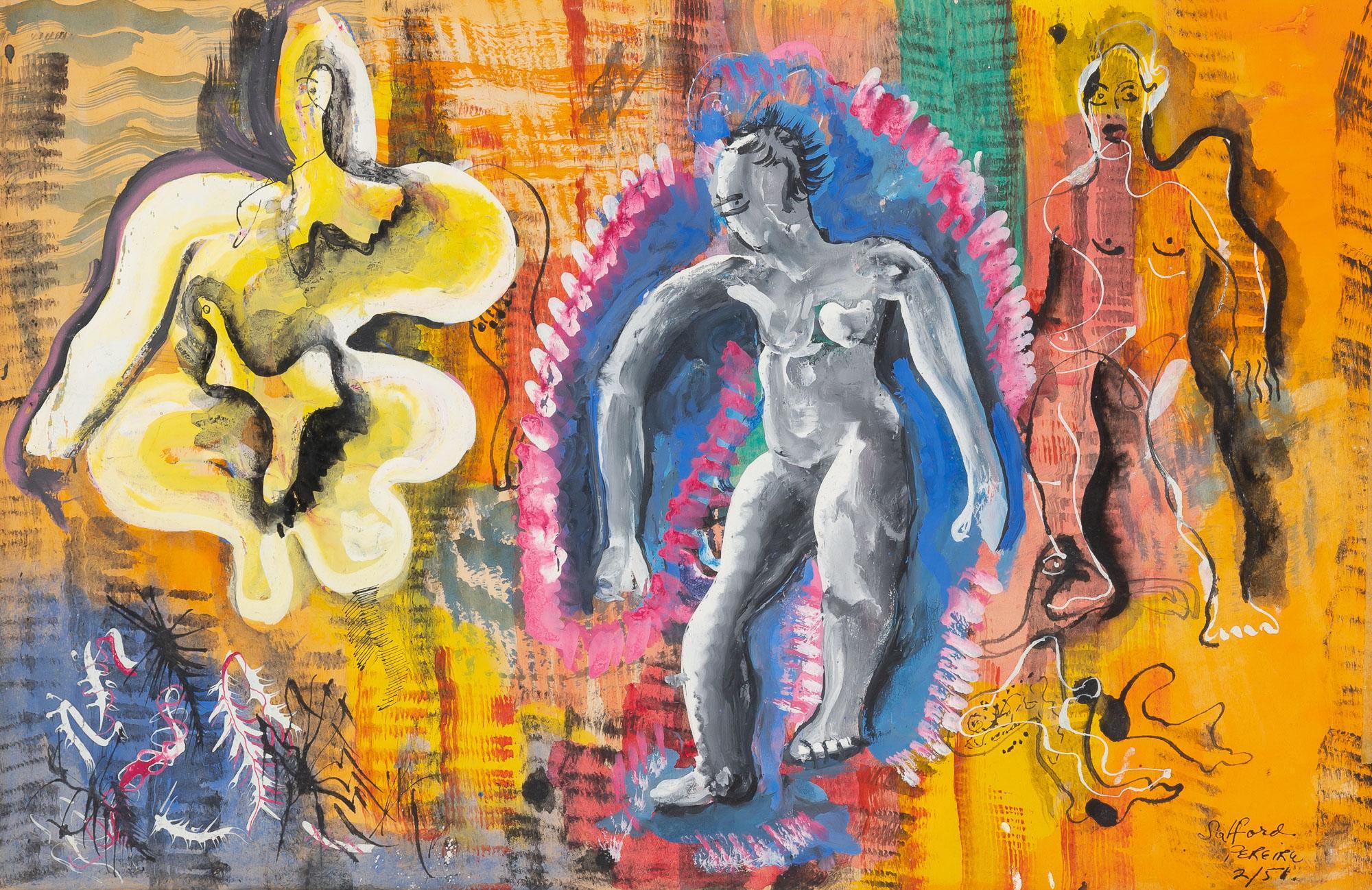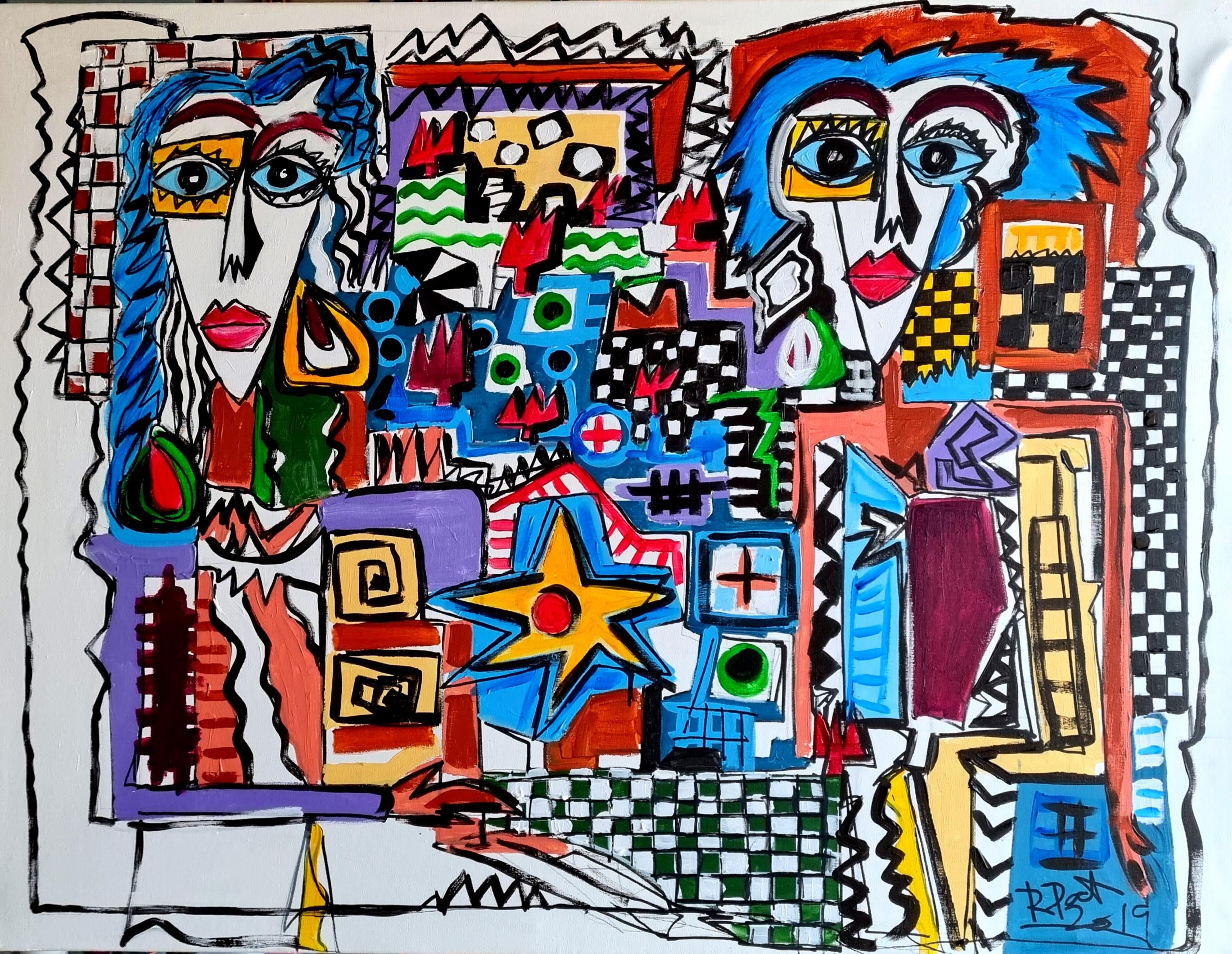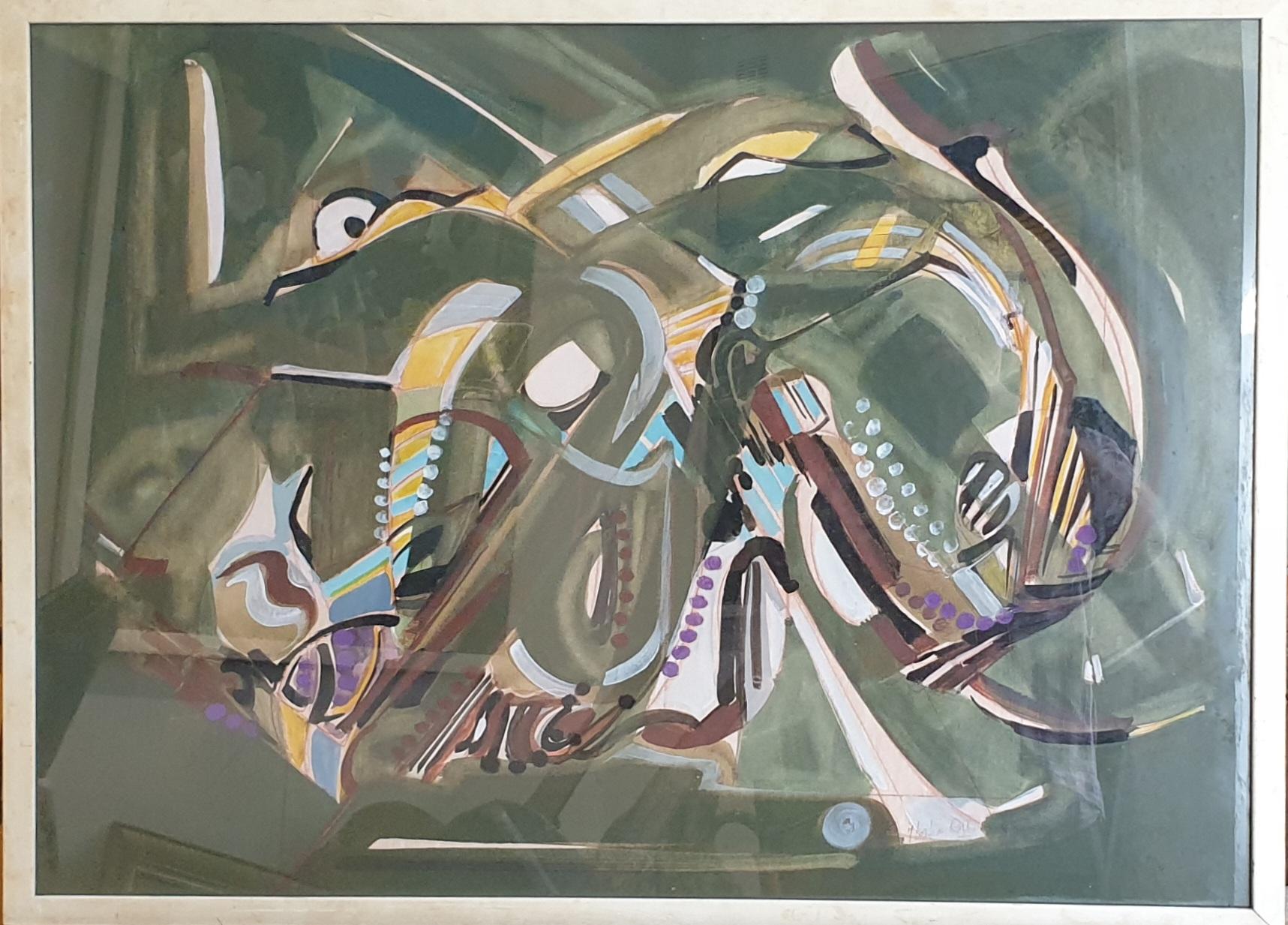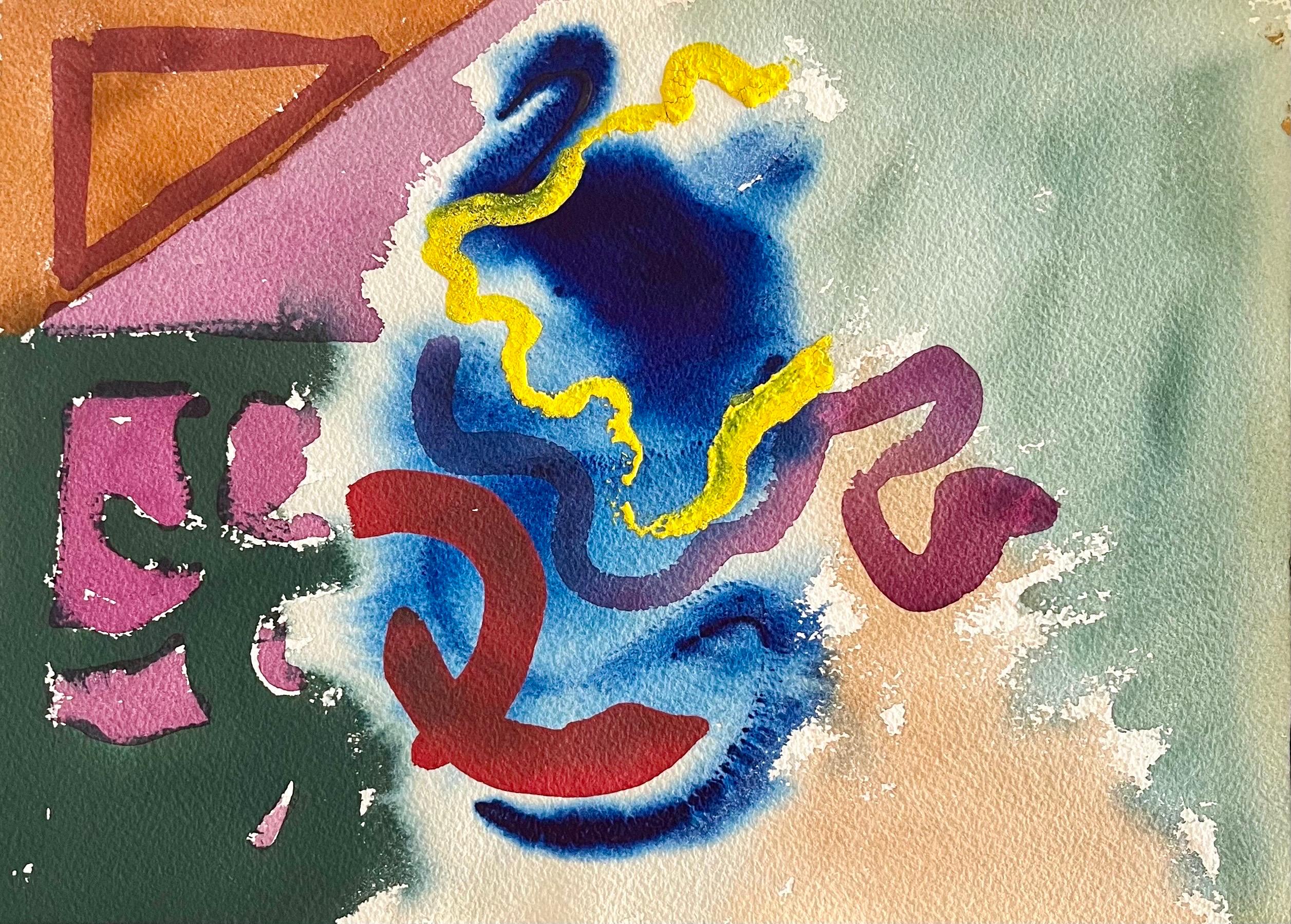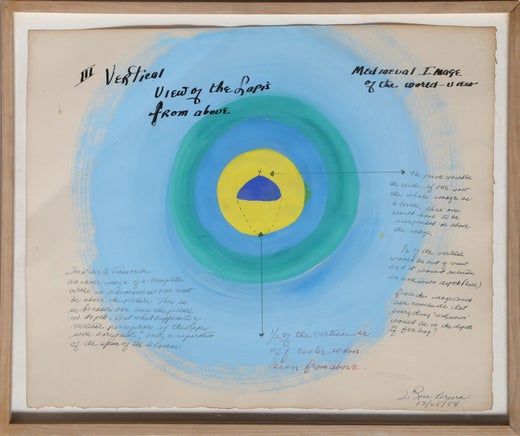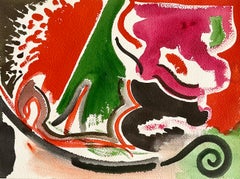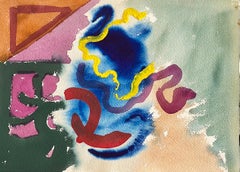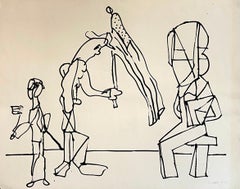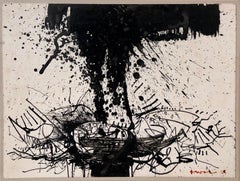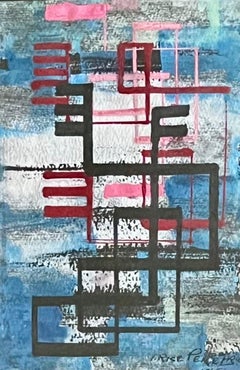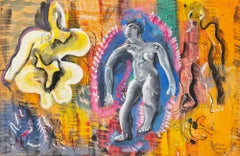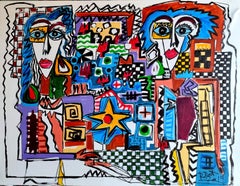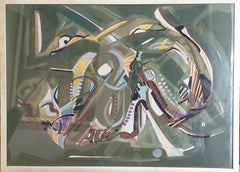Items Similar to Irene Rice Pereira Modernist Gouache Drawing Painting Abstract Expressionist Art
Want more images or videos?
Request additional images or videos from the seller
1 of 12
Irene Rice PereiraIrene Rice Pereira Modernist Gouache Drawing Painting Abstract Expressionist Art
$3,600
£2,729.87
€3,158.59
CA$5,088.73
A$5,672.96
CHF 2,958.68
MX$68,599.20
NOK 37,192.06
SEK 35,191.13
DKK 23,575.66
About the Item
Irene Rice Pereira,
Mixed Media on Paper (American, 1902-1971)
Titled "The East Wind Carries the Seed"
Hand signed l.r. "I. Rice Pereira".
Paper: 14.1/8"h x 18.25"w
Irene Rice Pereira (1902 – 1971) was an American abstract artist, poet and philosopher who played a major role in the development of modernism in the United States. She is known for her work in the genres of geometric abstraction, abstract expressionism and lyrical abstraction, as well as her use of the principles of the Bauhaus school. Her paintings and writings were significantly influenced by the complex intellectual currents of the 20th century.
Pereira was born Irene Rice in Chelsea, Massachusetts, a suburb of Boston, the eldest of three sisters and one brother. Her sister Juanita Rice Guccione was also a painter. During her career, she often gave her year of birth as 1907, which appears on some legal documents. She spent her childhood in Great Barrington, Massachusetts, where she spent time reading and writing poetry.
After her father died in 1918 she and her family moved to Brooklyn, New York. In 1922 she began working as a stenographer in an accountant's office to help support her family in the wake of her father's death. She briefly attended courses in fashion design at the Traphagen School of Fashion and night courses in literature at New York University, and began taking evening art classes at Manhattan's Washington Irving High School. She immersed herself in the bohemian world of Greenwich Village and had a brief affair with the poet and novelist Maxwell Bodenheim.
In 1927, she enrolled in night art classes at the Art Students League in New York City. Among her instructors at the Art Students League were Jan Matulka and Richard Lahey. In her 1929 class Matulka provided Pereira with her first exposure to the artistic principles of the European avant-garde that would shape her work; most notably those of the Bauhaus, Cubism, and Constructivism. Here, Pereira was exposed to the work of Pablo Picasso and Henri Matisse as well as the Cubists and Constructivists. and was encouraged to experiment with Cubist abstraction. In 1931, she traveled to Europe and North Africa to further her painting studies, attending sessions at the Académie Moderne and studying with Amédée Ozenfant in Paris. She also spent time in Switzerland and Italy.
After returning to New York in 1933 she studied briefly with Hans Hofmann at the Art Students League. Her friends and colleagues were Burgoyne Diller, Dorothy Dehner, David Smith, Hilla Rebay, Arshile Gorky, John D. Graham, and Frederick Kiesler.
In 1935, Irene Pereira helped found the Design Laboratory, a cooperative school of industrial design established under the auspices of the WPA Works Progress Administration. The curriculum of the Design Laboratory was similar to that of the Bauhaus. All students were required to take a basic course that included an introduction to chemistry, physics, and art materials. Students experimented with materials in laboratories in order to understand their physical properties. There was an emphasis on social considerations, and students were taught the social implications of technological developments alongside classes in art, music, and literature. Pereira taught classes in painting, composition, and design synthesis.
Pereira painted throughout her life. Her paintings first gained recognition in the early 1930s, when she exhibited at the ACA Galleries and the Whitney Museum of American Art in New York. With the showcase at the Whitney, she became one of the first women (along with Loren MacIver and Georgia O'Keeffe) to be given a retrospective at a major New York museum. In the late 1930s, she started to move away from figurative, realistic work toward abstraction and experimented with painting on layered glass. In 1943, Pereira was included in Peggy Guggenheim's show Exhibition by 31 Women at the Art of This Century gallery in New York Artists included:
Leonora Carrington, Perle Fine, Leonor Fini, Buffie Johnson, Frida Kahlo, Lee Krasner, Louise Nevelson, Irene Rice Pereira, Dorothea Tanning and Charmion von Wiegand. In 1946, Pereira was included in the Museum of Modern Art's exhibition 1946: Fourteen Americans along with Arshile Gorky, David Hare, Isamu Noguchi, Robert Motherwell and Theodore Roszak.
During the latter part of her career, Pereira rejected abstract expressionist art and experienced difficulties with gallery owners and museum directors. She believed that art and literature were being swallowed up in "a chaotic void of mindlessness." Eventually, she left New York permanently and moved to Spain.
She created "machine paintings" that incorporated images of technological components, including ship's ventilators, generators, and funnels, as well as hinges, levers, and gears. Boat Composite from 1932, in the collection of the Whitney Museum of American Art is an example of her "machine paintings".
Pereira began to explore abstraction in the late 1930s and her work included fewer references to machines. She became known for the geometric and rectilinear paintings created during this period. Abstraction from 1940, in the collection of the Honolulu Museum of Art, demonstrates her approach to geometric abstraction. She was interested in finding a way to bring light into her work, and began to incorporate materials such as glass, plastic, gold leaf, and other reflective materials into her paintings. She experimented with radium paint, layers of painted glass, and paint on parchment.
In a 1950 statement, she said "My philosophy is the reality of light and space; an ever flowing--never-ceasing--continuity, unfettered by man made machinery, weight and external likenesses. I use geometric symbols because they represent structural essences and contain infinite possibilities of change and dynamics."
Pereira signed her work as "I. Rice Pereira," which caused many people to assume that she was a man.
Irene Rice Pereira's first husband was the commercial artist Humberto Pereira, a painter, whom she married in 1929. They divorced in 1938 and in 1941, she married George Wellington Brown, a naval architect who shared her interest in applying new materials to art. When this marriage ended in divorce, she married the Irish poet George Reavey in 1950; that marriage, too, ended in divorce in 1959.
Pereira worked prolifically as a writer, but she never received the same acclaim in this area as she did in painting. She published her first article in 1944, titled An Abstract Painter on Abstract Art. Her writings included topics such as structure, time, optics, and space.
The Boca Raton Museum of Art, the Brooklyn Museum, the Hirshhorn Museum and Sculpture Garden, the Honolulu Museum of Art, the National Gallery of Art (Washington D.C.), The Phillips Collection (Washington D.C.), the Smithsonian American Art Museum, the University of Iowa Museum of Art, the Baltimore Museum of Art (Baltimore, Maryland), the Metropolitan Museum of Art (New York City), the Addison Gallery of American Art (Andover, Massachusetts), the Museum of Modern Art (New York City), the Dallas Museum of Art (Dallas, Texas), the Munson-Williams-Proctor Institute (Utica, New York), the Frances Lehman Loeb Art Center (Poughkeepsie, New York), the Whitney Museum of American Art (New York City), and the Philadelphia Museum of Art (Philadelphia, Pennsylvania) are among the public collections holding work by I. Rice Pereira.
- Creator:Irene Rice Pereira (1902-1971, American)
- Dimensions:Height: 14.13 in (35.9 cm)Width: 18.25 in (46.36 cm)
- Medium:
- Movement & Style:
- Period:
- Condition:
- Gallery Location:Surfside, FL
- Reference Number:1stDibs: LU38214309652
Irene Rice Pereira
Born Irene Rice, she took the name of her first husband, the commercial artist Umberto Pereira. She adopted the name I. Rice Pereira because then as now discrimination beset women in the arts. By the time war broke out Irene had divorced Pereira and married George Wellington Brown, a marine engineer from a prominent Boston family. Brown was an ingenious experimenter with materials, and he encouraged his petite new wife in their mutual passion for experimentation. Pereira in the 1930s was drawn to ships, not only because of George Brown, but because of their intricate machinery, their functional beauty. The inside-out infrastructure of the Pompidou museum in Paris amused Pereira, although she thought it art-historically tardy. Irene Rice Pereira was a lovely, fragile being. Her presence was hushed. She spoke almost in a whisper and listened far more than she spoke. She was a prodigious autodidact and a spellbinding lecturer. The main body of her metaphysical library today resides in the Museum for Women in the Arts in Washington, D.C. Her papers and the manuscript for her still unpublished book, Eastward Journey, are available to scholars in the Schlesinger Library at Harvard. Pereira won recognition for her abstract geometric work, particularly her jewel-like works on fluted and coruscated layers of glass, throughout the 1940s and early 1950s. In 1953 the Whitney Museum, then in Greenwich Village, gave her a retrospective exhibition with Loren MacIver, and that same year Life magazine published a centerfold photo examination of her work. By the late 1950s Abstract Expressionism had swept Manhattan, flattening such nascent movements as Geometric Abstraction. Such artists as Stuart Davis, Stanton MacDonald Wright, George L.K. Morris, George Ault, Jan Matulka, Richard Leahy, Philip Guston and many others were eclipsed. Pereira believed that a European angst, brought to our shores in the wake of the Holocaust, had introduced a cynicism and a profoundly anti-female sensibility that boded ill for art in America. Rightly she pointed out that even when the works of women were acquired by museums they were rarely shown, a disgrace that persists to this day. The women who did achieve success, she said, were often collaborators with more famous male artists and tastemakers. Pereira died in 1971 in Marbella, Spain, ill and broken-hearted. She had been evicted from the Fifteenth Street studio in Chelsea where she had painted for more than thirty years. Suffering from severe emphysema, she could barely negotiate a few stairs. But by the 1980s a new generation of women scholars and curators had begun to resurrect her stature. A considerable following has formed to honor a pioneer artist who cared about other artists and willingly paid the price to denounce what others feared in silence. Indeed when Pereira sold a painting she had two immediate impulses: buy a new hat, and give the money to an artist friend in trouble. She loved hats but loved to help fellow artists even more.
About the Seller
4.9
Platinum Seller
Premium sellers with a 4.7+ rating and 24-hour response times
Established in 1995
1stDibs seller since 2014
1,798 sales on 1stDibs
Typical response time: <1 hour
- ShippingRetrieving quote...Shipping from: Surfside, FL
- Return Policy
Authenticity Guarantee
In the unlikely event there’s an issue with an item’s authenticity, contact us within 1 year for a full refund. DetailsMoney-Back Guarantee
If your item is not as described, is damaged in transit, or does not arrive, contact us within 7 days for a full refund. Details24-Hour Cancellation
You have a 24-hour grace period in which to reconsider your purchase, with no questions asked.Vetted Professional Sellers
Our world-class sellers must adhere to strict standards for service and quality, maintaining the integrity of our listings.Price-Match Guarantee
If you find that a seller listed the same item for a lower price elsewhere, we’ll match it.Trusted Global Delivery
Our best-in-class carrier network provides specialized shipping options worldwide, including custom delivery.More From This Seller
View AllMod Abstract Expressionist Modernist Edward Avedisian Color Field Art Gouache
By Edward Avedisian
Located in Surfside, FL
Edward Avedisian Gouache Watercolor Abstract Painting on Arches paper. (notebook cover not included)
Unsigned, (bears name verso in pencil.)
Dimensions: 10" X 14"
Late 1970s, early 1...
Category
1970s Abstract Expressionist Abstract Paintings
Materials
Watercolor, Gouache
Mod Abstract Expressionist Modernist Edward Avedisian Color Field Art Gouache
By Edward Avedisian
Located in Surfside, FL
Edward Avedisian Gouache Watercolor Abstract Painting on Arches paper. (notebook cover not included)
Unsigned, (bears name verso in pencil.)
Dimensions: 10" X 14"
Late 1970s, early ...
Category
1970s Abstract Expressionist Abstract Paintings
Materials
Watercolor, Gouache
New York School Abstract Expressionist Drawing Watercolor Painting Carmen Cicero
By Carmen Cicero
Located in Surfside, FL
This is a stylized figurative abstract expressionist nude. This one is hand signed and dated.
From the style we are estimating it to the 1970's
They have abstract stylized erotic mal...
Category
1970s Abstract Expressionist Abstract Drawings and Watercolors
Materials
Ink, Watercolor
Abstract Expressionist Drawing
By John Levee
Located in Surfside, FL
Provenance: Darthea Speyer, Paris.
backing 12 X 17 image 8.5 X 11.5
John Levee (1924 - 2017) was an American modern art abstract expressionist painter who had worked in Paris since ...
Category
1960s Abstract Expressionist Abstract Drawings and Watercolors
Materials
Ink
New York School Abstract Expressionist Drawing Watercolor Painting Carmen Cicero
By Carmen Cicero
Located in Surfside, FL
This is a stylized figurative abstract expressionist nude. This one is hand signed and dated.
From the style we are estimating it to the 1970's
They have abstract stylized erotic mal...
Category
1970s Abstract Expressionist Abstract Drawings and Watercolors
Materials
Ink, Watercolor
New York School Abstract Expressionist Drawing Watercolor Painting Carmen Cicero
By Carmen Cicero
Located in Surfside, FL
This is a stylized figurative abstract expressionist nude. This one is hand signed and dated.
From the style we are estimating it to the 1970's
They have abstract stylized erotic mal...
Category
1970s Abstract Expressionist Abstract Drawings and Watercolors
Materials
Ink, Watercolor
You May Also Like
ABSTRACT American Woman Abstract Non-objective Mid 20th Century Modern Drawing
By Irene Rice Pereira
Located in New York, NY
ABSTRACT American Woman Abstract Non-objective Mid 20th Century Modern Drawing
Irene Rice Pereira (1902-1971)
Abstract
8 1/2 x 5 1/2 inches
Watercolor, gouache, and ink on black paper
Signed lower right
Framed by Bark
BIO
rene Pereira was born in 1902 in Chelsea, Massachusetts and grew up in Great Barrington. She was strongly influenced by her mother who was an amateur artist. Irene began art lessons at the age of fifteen; she took a secretarial job because her father had died. She took art classes at the Art Students League in New York City. At the age of twenty-one she married the first of three husbands, Humberto Pereira, whose name she kept.
She traveled extensively in Europe and North Africa and was much inspired by the expansive vistas of the Sahara Desert. Returning to New York, she began incorporating these visions into her work, increasingly experimental in her styles and methods. At first she painted on canvas, then she devised a means of actually incorporating light into her works by painting on layers of glass and mounting the layers together.
In 1942 she married George Brown, an engineer, who helped her experiment with a variety of materials. By the 1950s she became more interested in writing poetry and, divorced from Brown in 1952, she married George Reavey, an Irish Poet...
Category
1950s Abstract Abstract Drawings and Watercolors
Materials
Paper, Watercolor, Gouache
"Composition with Figure, " Irene Rice Pereira
By Irene Rice Pereira
Located in New York, NY
Irene Rice Pereira
Composition with Figure, 1951
Inscribed, signed and dated Salford/Pereira 2/51 (lr); inscribed I Rice Pereira/2669 Great Clowes St/Sa...
Category
1950s Abstract Abstract Paintings
Materials
Paper, India Ink, Casein
R. Poch The Kondos original acrylic painting
By Ramon Poch
Located in CORAL GABLES - MIAMI, FL
51.-The Kondos 115 x90 cm original acrylic painting
Born in Badalona (Barcelona).
Photographer and advertising film director.
Founding partner of the advertising production compan...
Category
2010s Abstract Expressionist Abstract Paintings
Materials
Acrylic
Late 20th Century Abstract Expressionist Gouache on Paper.
Located in Cotignac, FR
Lyrical abstract expressionist gouache on paper by French artist Michel Loiseau. Signed bottom right.
Michel Loiseau-Rizzo, born in 1937 is an illust...
Category
Late 20th Century Abstract Expressionist Abstract Paintings
Materials
Paper, Gouache
$872 Sale Price
54% Off
Mid century Modern 1960s Abstract Expressionist painting, renowned artist Signed
Located in New York, NY
Jack Wolfe
Untitled, 1965
Acrylic and collage on board
Hand signed on the front
Frame included: held in original vintage frame with original gallery label
Unique
Provenance: Parker Street 470 Gallery, Boston, Mass (with label verso)
Excellent abstract expressionist mixed media work.
Measurements:
Image:
17" x 24"
Framed:
24" x 28" x 1"
From Wiki:
Jack Wolfe (14 January 1924 – 18 November 2007) was a 20th-century American painter most known for his abstract art, portraiture, and political paintings. Jack Wolfe was born in Omaha, Nebraska on January 14, 1924, to Blanche and Everett L. Wolfe. Soon after his birth, his family moved to Brockton, MA. At 18, Wolfe had an interest in commercial illustration, which he pursued at the Rhode Island School of Design (RISD). However, upon matriculating at RISD in 1942, he developed an interest in fine art and painting inspired by an exhibition of modern French art. He described this change of direction, explaining that, "One day, for the first time, I saw an exhibition of modern French art. It was like being struck by lightning." He became particularly interested in the work of a number of European modernists, including Rouault, Cézanne, Braque, Modigliani, and Picasso.[1] Following his time at RISD, he pursued a Master’s in Fine Arts degree at the Museum of Fine Arts School in Boston, MA. At the Museum School, Wolfe studied under the renowned Expressionist Karl Zerbe, a German-born artist who was the Museum School's most influential and vital teacher until 1953.[2] After graduating from the Museum School, Wolfe was represented by the Margaret Brown Gallery in Boston, which also represented many other cutting edge Moderns that defied the more conservative tastes of New England collectors at the time, including György Kepes, Congur Metcalf, and Alexander Calder.[3]
Career and Museum Representation
Jack Wolfe's painting "Robin's Rock" 1962, 72" x 72"
Jack Wolfe's artwork received early recognition from a number of organizations and was consistently featured in influential exhibitions, including the 1955 Carnegie International at the Carnegie Institute in Pittsburgh, PA, the American Federation of Art's traveling exhibition New Talent in the USA in 1956-57, the Whitney Museum’s Young America exhibition in 1957,[4] the Boston Institute of Contemporary Art's Selection exhibition in 1957,[5] and both the Whitney Museum’s 1958 Annual exhibition and its Forty Artists Under Forty show in 1962-63.[6] In 1959, his widely acclaimed Portrait of Abraham Lincoln toured Europe in a show circulated by the Institute of Contemporary Art, Boston. In addition, his painting Crucifixion was chosen by the United States Information Agency to be exhibited across Europe, including being shown at the Salzburg Biennial in Austria in 1958.[7] Crucifixion was also exhibited at the Whitney Museum and subsequently displayed in the National Cathedral in Washington, DC, in 1958.[8] In 1966-67, his work was selected for Art for Embassies by the U.S. State Department.[9] He received the first annual Margaret Brown Memorial Award for high achievement by a New England Artist from the Institute of Contemporary Art, Boston, in 1958.[10]
With his future as one of the great artists of his time laid out neatly before him, Wolfe moved to New York in the early 1950s, which was then the postwar epicenter of the art world and in the midst of experiencing the first real revolution in American Art, now known as Abstract Expressionism.[11] However, almost immediately upon his arrival, he became disenfranchised with the overtly commercial nature of the art scene there, spurning fame and security in an unwillingness to bend his creative vision to the expectations of others.[12] After four short months, he left New York, returned to Massachusetts where he bought property in Stoughton, cleared the land, and built both his home and studio with his own two hands. He would go on to live and paint there, extensively exhibiting and garnering constant critical acclaim.[13]
Wolfe became one of the earliest artists championed by the deCordova Museum in Lincoln, MA and the Institute of Contemporary Art in Boston. He was awarded a traveling scholarship in 1958,[6] which allowed him to set up studio in San Miguel de Allende, Mexico and then in San Francisco, California.[14] Upon his return in 1959, the deCordova museum hosted Wolfe’s third solo exhibition, featuring work made during his time in California...
Category
1960s Abstract Expressionist Abstract Paintings
Materials
Mixed Media, Acrylic, Gouache, Permanent Marker
Untitled II Abstract Expressionism
Located in Lake Worth Beach, FL
Untitled II Abstract Expressionist
Artist signed lower right corner on reverse Mixed Media on canvas.
Julia Habrat was born in 1997 in Kraków Poland, She graduated from the Univers...
Category
2010s Abstract Expressionist Abstract Paintings
Materials
Canvas, Oil, Acrylic, Pigment
More Ways To Browse
Structural Art
Mid 20th Century Gouache Painting
Art Moderne Light
North African Art Paintings
Mid Century Abstract Cubism Art
Man Reading Painting
Naval Paintings
Paintings By D Smith
Brothers And Sisters Painting
Picasso Gouache
1930s Cubist Painting
Art With Swallows
Three Sisters Vintage
Georgian Period Paintings
Frida Kahlo Painting
1930s Industrial Painting
C Williams Painting
Georgia O Keeffe Paintings
